Blog
-
Saviour: Your questions answered

Saviour is amazed by your questions from around the world.
Last Thursday, we followed ten-year-old orphan Saviour for the day on her 14km round journey to school. We asked you to send us questions for her by Twitter and email. Here’s the top five answers.
What do you like most about school?
I like coming to school to see all my friends. I also like learning things.
What do you want to be when you grow up?
I want to be a teacher, like Mrs Haloba.
What’s your favourite lesson?
I like English the most, and also maths and CTS (Creative Technical Skills).
What happened to your family?
My mother and father died when I was just a baby. Now I live with my Uncle and my Grandmother. She’s not here at the moment, but is coming back soon.
What toys do you play with at home?
I have a ball which I made myself out of plastic bags. I take it into the fields behind my house to play.
0 comments -
You can’t teach a thirsty child

Drinking water at the disabled compound near the school.
Yesterday was our last day at Simakakata school, and it’s hard to believe we are leaving so soon. Photographs, phone numbers and email addresses were exchanged with the staff, and there are so many stories still untold. The teachers: George, Sonia, Beatrice, Loveness and Edwin are inspiring. The children: Holiness, Universe, Saviour, Irene, Valencia, Victor, Brighton… all of them, they deserve so much more than they have, yet are outrageously happy with their lot.
The first class of the day was Sports, starting at 7.30am. It was a chance for the pupils to show off their football and netball skills, and us to teach them the three legged race. Shoes were stripped of their laces to tie ankles together, because the school can’t afford string or rope.
It’s getting hotter, too. The last rain was a couple of weeks ago, and they won’t see any more until November. The sun is noticeably more fierce than it was on our walk with Saviour last Thursday.
The sports field is about 500m from the school. The last match finished at 9.45, and the children sprinted off back to school. They ran straight past the crumbling building without stopping.They were thirsty.

Netball practice at Simakakata
At the moment, the only water source for the school is a manual borehole pump in the nearby disabled compound. It’s closed to the children between 10am and 1pm, to conserve supply.
The children were running to fill their cups before the pump was locked.
In a few months, even this borehole will run low and the children will be turned away until the rains begin again in November. In the meantime they’ll have to rely on the bottles of untreated, stagnant ditch water they bring with them from home. Those who get sick with diarrhoea from drinking it will have to stay at home, miles from the nearest clinic.
When they get kicked out of the farmhouse they’re currently using, they’ll study in a temporary shelter with no walls near the planned site for the new school. It’s further away from the precious water source at the disabled community than the sports field currently is.
Children who are tired and thirsty don’t learn well. Halting classes for a 20 minute round trip to fetch water is disruptive. Without an on-site source of clean water, they can’t wash their hands before eating, after using the latrines or scrubbing the floors with leaves at the end of class.
It’s not just the children. Several staff will need to live on site at the new school because of its location. It’s a lot to ask if you can’t even offer them a tap.
The current volunteer teachers have already forgone that luxury, but they shouldn’t have to.
There’s no water main here. There’s no sewer system and for seven months of the year there’s no rain. That’s why the cost of a borehole is included in the building costs for the new school at Simakakata.
The school at Simakakata needs fresh, clean water for the staff and pupils.
To drill a borehole at Simakakata will cost £7,500. If you’d like to help, please click here.
-
The teacher: Sonia’s story
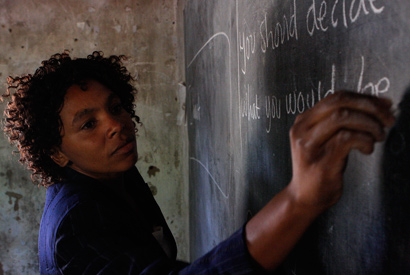
Sonia Haloba Shanegubo aims to inspire her pupils to break out of the cycle of poverty.
Sonia Haloba Shanegubo is the only teacher currently at Simakakata Community School other than headmaster George who is paid a salary by the government. A third is currently on maternity leave, but there’s no replacement during her absence.
Many government trained teachers won’t take jobs in rural schools with no housing or amenities: Sonia is here because she believes a quality education is the only thing that will rescue the children of Simakakata from a cycle of poverty and dependence. The commitment and determination she has shown to get where she is is daunting.
Sonia teaches the grade 3 class in the morning, and grade 1 in the afternoon. She is young, quiet and smartly dressed. Amazingly, her white skirt doesn’t show a single speck of dust from her commute this morning: even though she has to walk 7km along the main road between here and her house in Kalomo twice a day.
She has two children, four year old Ed and 16 month old Endy, who is still breastfeeding.
“As long as the school is in operation, I will be here,” she says, “I want to teach the children so that in the future they can be like me, and do something different. Something that will help communities like Simakakata.
“The most important thing we can do to help the children here is help them go to school. There are children here whose heads are full of knowledge, but there is no-one to push them and help them get ahead. So they just go hunting, do whatever, end up begging in Kalomo.
“I want them to have a better future and not end up as street kids.”

Many days Sonia teaches grades 1 and 2 together as attendance levels are hard to predict.
The teachers here understand exactly the problems and challenges their children and their families face when it comes to education.
“I grew up just here in Kalomo,” Sonia says, “With one single parent, my mother. We lived with my grandmother. There are six children in my family, and I am the first born.”
Sonia’s mother died in 1999, when Sonia was 18. Her youngest sister was barely a year old. Sonia’s boyfriend, Edwin Mwenda, paid Sonia’s tuition fees so that she could go back to high school and graduate. They married in 2002, and in 2003 Sonia went to Livingstone to train as a teacher. There’s no government support for teacher training here: the family was reliant on Edwin’s income as a lorry driver to support her brothers and sisters, as well as pay her college fees.
After her training, Sonia volunteered to teach at a Community School in Mazabuka district. It was an even more remote setting than Simakakata. The nearest tarmaced road was 15km away. Many teachers here work at their first post for free, while waiting for the government to ‘deploy’ them. The wait can be up to three years.
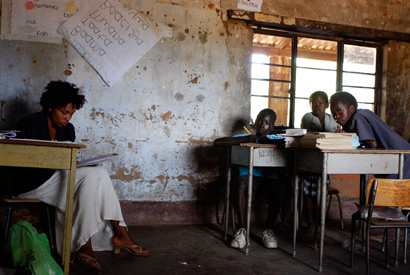
The current school is far from ideal, but there
Sonia stayed at her school after deployment, but moved to another community near Kalomo after her grandmother died.
“I wanted to push my brothers and sisters so they would go to college,” Sonia says, “So I decided to sponsor my sister at college. I used money we earned buying goods like DVDs and music cassettes in Botswana to sell here to pay for her schools fees. My husband has to drive there often.
“Once my sister was trained as a teacher and deployed, she wanted to educate our younger sisters and brothers. So my sister sponsors one, my oldest brother sponsors one and I sponsor two through school.
“We now have enough that my second youngest brother, who is working in a shop in town, can go to college next year.”
Sonia knows that Simakakata Community school needs help from outside the community to get it established, but believes that the whole project will be self reliant once it’s completed.
“The most important thing we have to do is push those children in the community who are failing to go to school, to get them back to school. Encourage them to do something other than stay in the fields all day. We can help the parents too, those who need to go back to school to learn to read and write can.
“We should teach the parents projects like sewing, making baskets, beancraft that they can sell to find money to help children to go skills.”
Sonia is self-effacing and quiet when talking about her own story and incredible achievements. But when she talks about the need for education in Zambia, she is fast, loud and enthusiastic.
“I have seen a lot of people with a lot of difficulties in life. You can have the courage to want to go to school, but if there’s no one to help… I pity such people.”
The government will only send teachers to schools if there is accommodation for them.
A small house for teachers’ accommodation costs just £4,500 and will help Simakakata attract more exceptional people like Sonia to work at the school. If you’d like to donate, click here.
-
Saviour’s story: A day in the life of a 8-year-old orphan. (3/3)
On Thursday we followed 10-year-old orphan Saviour through a typical day. The final third is a mirror image of the morning. A 7km walk home, where she is visibly tiring, followed by a small meal of nshima and more chores. By the time she is finished it’s 6pm and the light is rapidly fading. There is no time for homework before bed.
Photography by Brenda Veldtman.

Just after 3.15pm the children start the 7km walk home.

Despite the distance that lies ahead they are still in high spirits. They love having the chance to go to school.

As a 10-year-old Saviour should be in grade 4, but it's only recently that she has become strong enough to do the 14km round trip every day.

That's 70km of walking per week. Or 2,800km in a school year.

2 hours after they set off the children are back at Chibwe Farm and it's time for dinner.

The children are glad to have a second meal of the day. In a few months time the food from the harvest will be very low.

Yet more chores.

The family enjoy some quality time together around the remains of the fire.

As the last of the light starts to disappear an exhausted Saviour heads to bed.
At a quick glance the school at Simakakata looks quite good. It’s a borrowed farmhouse. A little dark perhaps, but there are four walls and a roof that doesn’t leak too much. But there is a big problem. The community doesn’t own the building and the organisation that does wants it back.
Simakakata desperately needs a new school.
A total of £5,200 is needed to fund the first classroom for Saviour and her friends. Once the community has started construction, we’ll post regular updates so you can see your money in action. Click here if you want to make a donation.
-
Saviour’s story: A day in the life of a 8-year-old orphan. (2/3)
On Thursday we followed 10-year-old orphan Saviour through a typical day. Her walk to school takes 2 hours. And when she gets there her classes are Maths, Creative and Technical Skills (CTS), English, Tonga and Social Development Studies. This is part two of her photo story.
Photography by Brenda Veldtman.
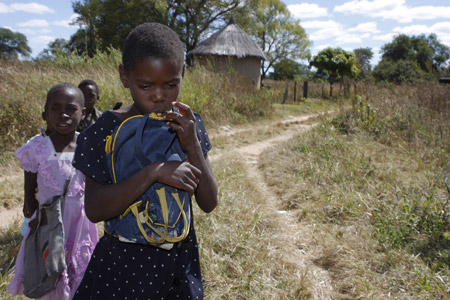
It's boiling hot and walk to school takes the children just over 2 hours. In that time they drank no water.
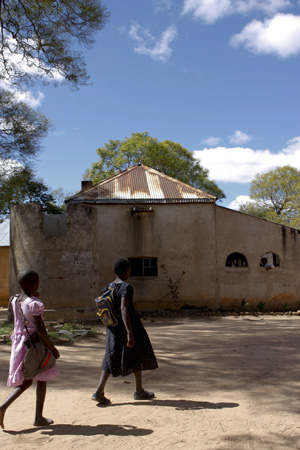
Saviour and her friends finally arrive at school. The temperature is 27 degrees in the shade.
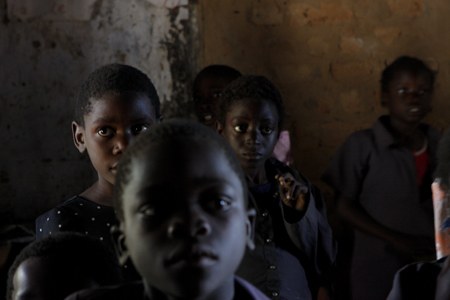
Saviour joins her grade 1 classmates and files into class for the first lesson of the day.
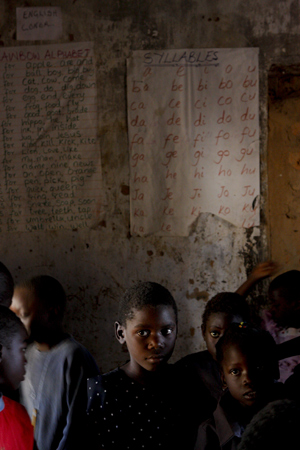
There are no teaching aids for the walls. Everything has to be painstakingly written out by hand.
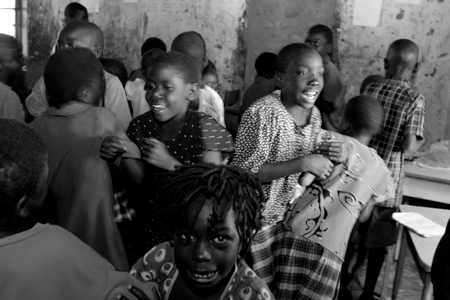
The children head for their desks.

The first lesson of the day is Maths.
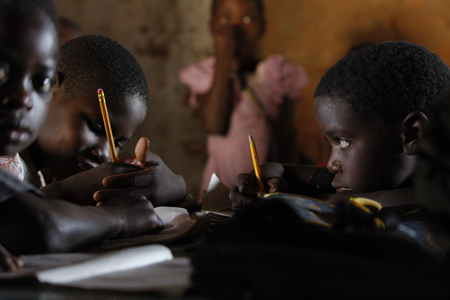
Time for the dreaded test. No cheating please!
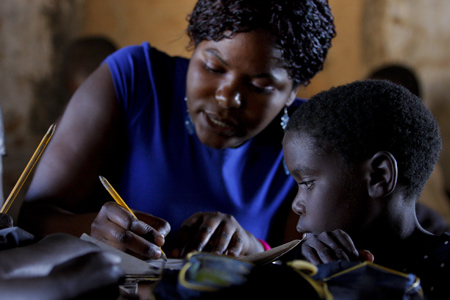
Beatrice gives Saviour a little one-to-one tuition.
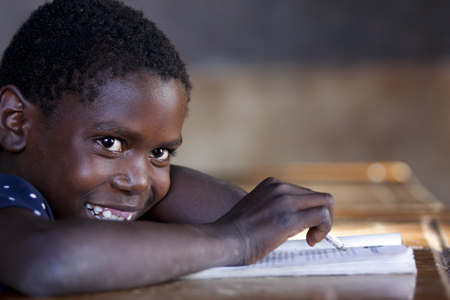
Saviour loves having the opportunity to go to school.
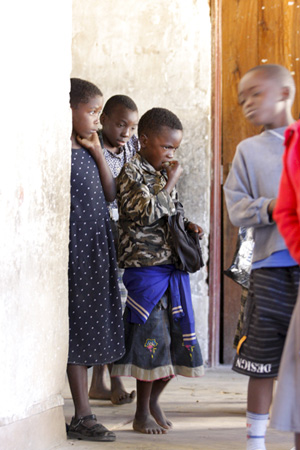
3 hours later Saviour's lessons are over for the day.
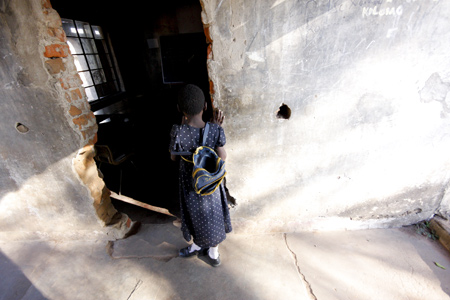
Saviour waits to get a letter off Headmaster George. Doors are seen as luxury at Simakakata.

The classrooms at Simakakata look quite good. But there is a major problem. The school is a borrowed farmhouse and the owner wants it back.
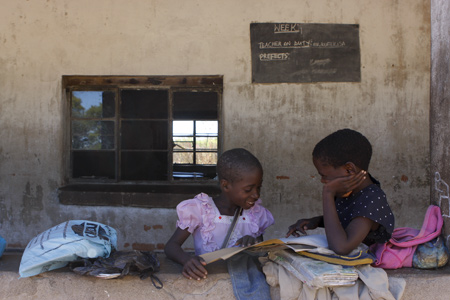
Saviour and Valencia find half an hour to do their homework before they set off home. They still have chores to do and it will be too dark to do any later.
-
Saviour’s story: A day in the life of a 8-year-old orphan. (1/3)

Photographs by Brenda Veldtman and Steve Heyes.
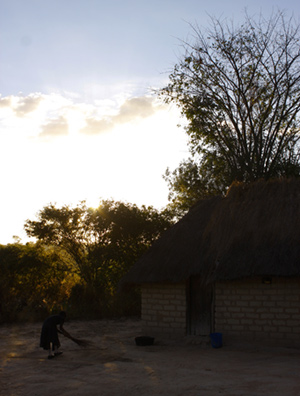
Saviour lives on Chibwe farm. She gets up before 7am to do her chores. Here she is keeping an eye out for snake tracks.

Then it is time to start preparing breakfast.

Nshima is on the menu this morning. The same as every morning.

While the food slowly cooks Saviour and her cousin Valencia grab a bucket and a jerry can and run off into the bush.
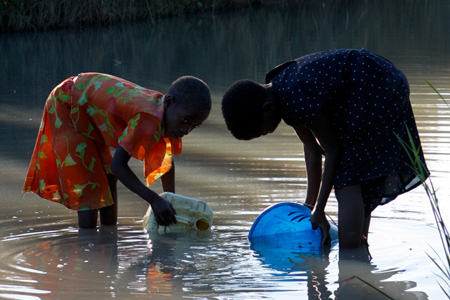
We find them half a kilometre away, collecting water from a nearby stream. It's filthy. We later learn that animals drink from the same water source.
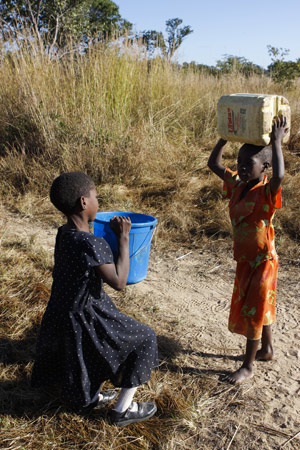
Saviour struggles to lift the bucket onto her head.
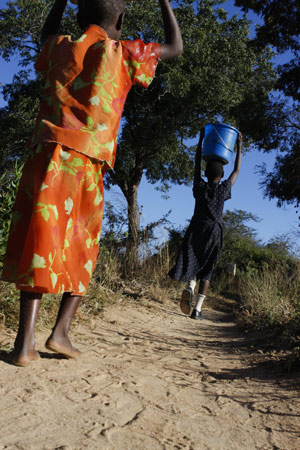
But she manages and the girls head back home.

Aunt Vivian has finished preparing breakfast. Sorry dog, there won't be any left overs.
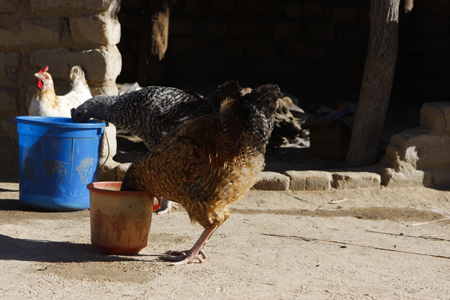
But it doesn't take long for the chickens to spot the water.
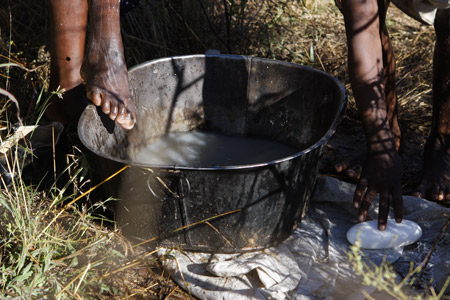
Saviour heads back into the bush for a quick wash.

Then the children begin the 7km walk to school as a cow from the community farm looks on.

Saviour picks some muchinga-chinga berries to snack on. It's just two months after the rainy season ended and the fruit is plentiful.
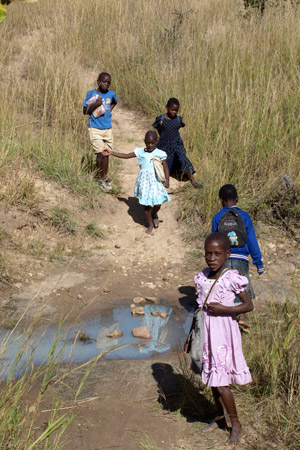
The children take a short rest by a stream. At the height of the five month rainy season it can become uncrossable.
Click here to see part 2 of the story.
-
£34,200 more needed to completely fund the school at Simakakata.
Updated 4 January 2010.
The commitment of the Simakakata community is inspiring. They started by making over 60,000 bricks by hand and are now contributing skilled and unskilled labour for free to construct the first four classrooms.
What they can’t do is pay for the building materials such as cement, windows, timber and roofing sheets for the final classroom and five teachers’ houses they badly need. Here is a breakdown of the community’s requirements:
£5,700 - Classroom (1 more needed)
£5,700 - Teachers’ house (5 needed)
£7,500 - Bore hole (funded by the local council)
£34,200 TOTALPlease click here if you would like to make a donation.
You’ll get to see regular updates from the school and hear ongoing stories from the people your money is helping.
Note: In Zambia if you provide the funding for a teachers’ house the government will provide a trained teacher for free.
-
Saviour’s story: A day in the life of a 10-year-old orphan
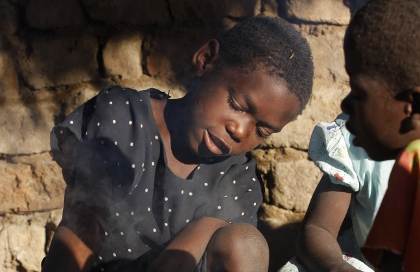
Saviour in her community just before she set off for school.
Saviour is a 10-year-old girl from Chibwe Farm. She lives with her Uncle Kennedy Mantantilo, his wife Vivian and their four children, Irene, Valencia, Chipo and baby Chileleko.
Saviour is in grade one at Simakakata community school. Until now, she was too small to walk the 14km round trip every day for class. Her family kindly agreed to let us spend the day with Saviour and see what a typical 24hours for the girl is like.
Here is a live blog of her day. Click here to see the story in pictures.
06:50
The farm is the closest thing we’ve seen to a recognisable village structure so far. Around 100 people live here, half of which are children of school age. Over 30 of the children go to school in Kalomo, 14KM away. They live in a boarding house the community owns in town, and return maybe once every two weeks to see their parents. While they’re away, they cook and care for themselves.
07:00
Saviour and her friends would normally set off walking now. Their lessons start at 11am, but it’s too hot later in the day and they don’t want to be late. Before we leave today, though, Saviour shows us her morning chores. She sweeps the yard, looking for dust blown in front of the shack and snake trails, then washes a few pans from the night before.
07:15
Saviour walks 500m to a small stream which even now, after the rainy season, might as well be stagnant. The villagers wash their clothes here, and the cattle drink from the same place. Saviour fetches a bucket from the supply to make nshima for breakfast. A chicken drinks from one of the children’s cups which has been left unattended.
Saviour and her cousin Irene walk into the tall grass to wash in water collected from the stream and dress for school.
09:00
The villagers of Chibwe spend some time talking to us and explaining how the farm works, so we’re very late setting off for school. George, the headmaster at Simakakata has joined us for the walk, to look after the children and help explain things as we go along. Usually, the five children - Saviour, Valencia, Irene, Sharon and Alex - would walk unaccompanied.
09:30
The children pick some muchinga-chinga berries to snack on. The small red berries are sweet, but with a not unpleasant sour aftertaste - like a Haribo sweet.
09:40
The children start chasing each other and playing games. George explains that the average teacher wage in Zambia is 1.8million Kwacha per month, or £200. Before he chose to come to Simakakata, he worked in a school with running water, electricity and proper cooking facilities. He’s here because he wants to be, and other teachers won’t work in these areas for the salary.
10:00
George explains that there are around 50 elephants loose in the area, which they think have come up from game parks in Zimbabwe, where they’re being hunted for food. He’s worried for the safety of the children who walk this far every day.
10:20
We’ve covered about 5km. We’re fairly sure the children would be moving faster without us. Irene has stolen Steve’s sunglasses.
10:30
George sees a young child leading a cow through a cornfield and calls him over. The child should be at George’s school, the child says he has no clothes that are clean enough to attend and needs to work.
11:00
For the last 500m we try taking our shoes off to see how hard the ground is. Of the five children, three are barefoot. We notice more sharp pebbles, ants and the occassional piece of broken glass than we did before.
11:10
We arrive at school, slightly late, but headmaster George says it doesn’t matter. He is happy to do anything that will help raise badly needed funds for the school. Saviour goes straight into a maths class, where she’s learning to write the nnumbers 1 to 4.
11:30
The classes for grade 1 are just half an hour long. Saviour’s second class is CTS - Creative and Technical Studies. Music, art, home economics are all taught in this class.
12:30
The children break for lunch. Those who’ve brought food eat. Saviour hasn’t. They play in the yard and throw sticks into the nearby tree to knock out the fruit.
13:30
The last class of the day is SDS - Social Development Studies. The children sing “Head, shoulders, knees and toes” to learn the English names for different parts of the body. There are over 70 languages in Zambia (popn 11 million) so English is a vital lingua franca.
14:30
The end of day bell rings and the children sing a song about the end of the school day. They spend half an hour playing in the yard before the long walk home.
15:10
Saviour and her cousins start the long walk back. To pass the time we start to sing songs - the children sing some in Tonga, and we teach them some English ones.
15:40
A woman whose house we passed earlier stops us to talk to George about writing a letter for her, Saviour and her cousin Irene run off to the stream behind her house and come back with a bottle full of filthy ditch water.
16:30
We pass over a dry river bed, the children spot a pig which has escaped from a nearby farm and try to shoo it back. Unlike goats and cattle, pigs are usually kept indoors, so it’s unusual to see them roaming.
17:20
We arrive back home at Chibwe. The children are all still full of energy, despite having walked for four hours today, and not having eaten anything other than muchinga-chinga berries since breakfast. Saviour eats a snack of cold nshima, the corn starch dough which is the staple diet here. It’s leftover from the rest of the family’s lunch.
17:30
It’s chore time, and Saviour washes the pots from the preparation of the bean stew that’s cooking in the yard.
17:40
The family sit down to eat. It’ll be dark by 18.00, and with no candles there’s no time for any homework to be completed before the light is lost and it’s time for bed.
Do you have any questions for Saviour?
If you have any questions for Saviour, please let us know via Twitter or leave a comment below.
Saviour’s story can also been seen in photographs via this link.
-
I want to be…
We want to help the schoolchildren of Simakakata do more than just read and write. We want to help them to achieve their dreams.

Sonet
“I want to be like my favourite teacher, Mrs Shanegubo.”

Mulemwa
“I want to be a secretary in a bank in Lusaka, so I can earn money. I’ll send some back to my family in Simakakata.”
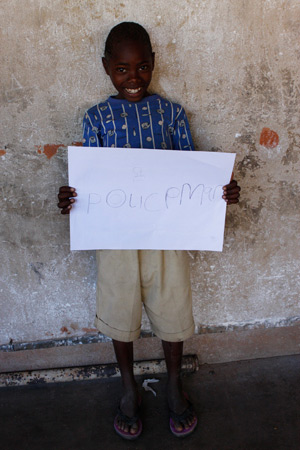
Gregory
“I want to be a policeman, and catch bad people.”
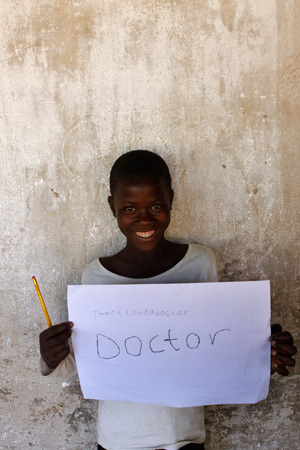
Dorothy
“I want to go to Lusaka and train to be a doctor, so I can help people.”
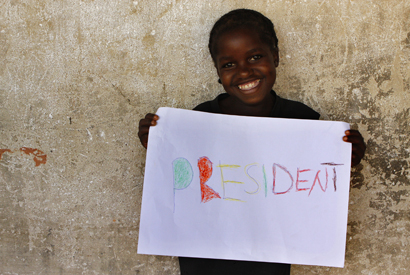
Choolwe
“I want to be the President, so I can make all the rules.”
-
What the community still needs
Today we were invited to attend a community meeting, organised by the school PTA (Parent Teacher Association), to discuss the exact needs of the school.
Fifty people walked to the present school for the meeting, and we posted comments on Twitter as they spoke. They were unanimous about the order they need things to be completed.
Firstly, they told us, they need to build a classroom. The school was supposed to vacate its current premises in August last year, and there’s a good chance that by the time this August comes round, their stay of execution will have expired. They can move the children to a temporary shelter – a basic wooden construction in a field – for classes, but they need a building to store their books and records.
These aren’t just school documents that need a safe, dry home. The headmaster also organises community volunteers to make regular rounds of the village to perform basic health checks and keeps files for this vital function. He lives outside the community, in Kalomo, and cycles every day to work. Transporting what he needs every day would be impossible.
For that reason, the school building should, ideally, also have a small office.
The current plan
Initially, the school will be just this building and the temporary shelter for the older children.
The next priority is for teacher housing. They cannot attract permanent, government trained staff unless they can offer them a home within easy reach. Two trained teachers currently volunteer full time at the school, and live in a shack with no door in the compound.
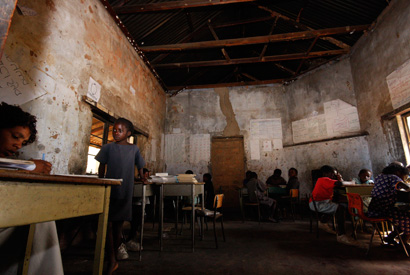
It's not much of a classroom, and soon the school won't even have that
After that, they say, the most important thing is a borehole. Without water, the children find it have to waste time fetching water difficult to study, the live-in staff have nothing to drink and it’s impossible to maintain anything kind of basic hygiene.
To complete the school will take approximately 7,200 man hours of skilled and unskilled labour. To get in contractors to finish the construction, the wages would be around 10,000 Kwacha per hour per worker. That’s approximately £1.20 (or $2), which is the average daily income in Zambia. There’s no way Simakakata can afford to pay.
The women and children will also contribute by providing food and fetching water to the build site.
If making the remaining materials – doors, iron sheeting for the roof, window frames and glass - was possible, these people would do it.
Until they have them, they cannot get further investment from the government, and the quality of teaching will inevitably suffer.

The crumbling brickwork of the classroom doorway
A year ago, there were no qualified teachers at Simakakata school. The difference that trained staff have made to the quality of education and the lives of the children and their prospects has been indescribable. Nearly all of the children are behind the standards for their grade, though, and only with money for new buildings can their work here improve.
They need your help, please follow the story and donate.